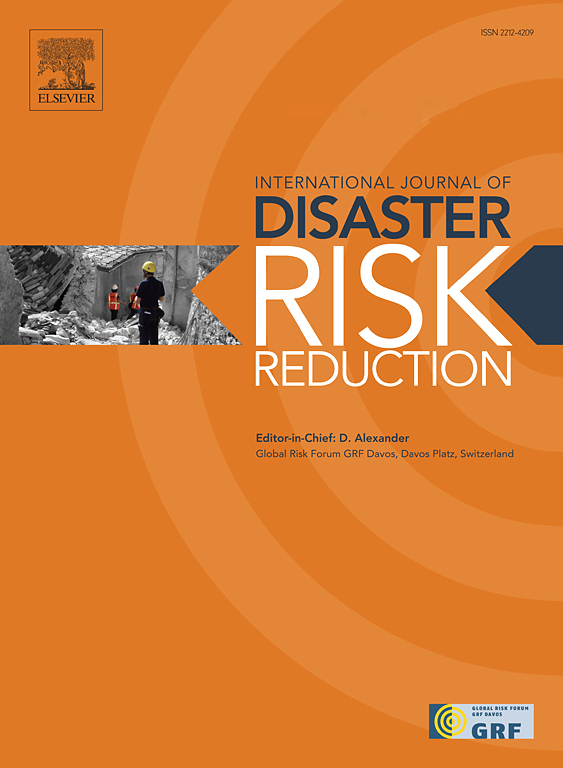Comprehensive analysis of data aggregation techniques for flood vulnerability and bivariate flood risk mapping of a coastal urban floodplain
IF 4.2
1区 地球科学
Q1 GEOSCIENCES, MULTIDISCIPLINARY
International journal of disaster risk reduction
Pub Date : 2025-03-01
DOI:10.1016/j.ijdrr.2025.105330
引用次数: 0
Abstract
Aggregation techniques that are frequently used to quantify indicator-based flood risk or vulnerability are often prone to rank-reversal problems. This necessitates the need to identify a robust aggregation technique in this context. This study aims to develop a framework for mapping flood risk by quantifying indicator-based flood vulnerability using a reliable data-aggregation technique. Further, this approach is integrated with hydrodynamic modelling to assess flood hazard, while considering potential near-future Land-Use-Land-Cover (LULC) changes. Total 12 indicators were identified and categorized into physical, socio-economic, and environmental vulnerability components. Among the widely employed techniques that include Analytical-Hierarchy-Process (AHP), entropy, Principal-Component-Analysis, integrated AHP-TOPSIS, and AHP-Entropy, AHP-TOPSIS approach is found to be more stable to rank-reversal problem. Therefore, using AHP-TOPSIS approach, flood vulnerability is quantified. A quasi-2D hydrodynamic model has been used to predict flood depth, velocity, and momentum for flood magnitudes of 1 in 50-, 100- and 250-year return periods, while accounting for projected LULC changes of year 2035. Flood risk is then mapped using bivariate choropleth scheme which inherently distinguishes dominant element among hazard and vulnerability. Additionally, adaptive capacity of the region is mapped by considering temporary-shelters, building-heights, literacy, and road-network. The results showed that the regions falling under high to very-high flood risk categories are constantly increasing under the influence of LULC changes as well as increasing flood magnitudes. Although urban areas exhibit high vulnerability, high adaptive capacity helps mitigate the risk of loss of life. However, damage to infrastructure and the economy exist. These findings provide insights for effective non-structural flood mitigation strategies.

求助全文
约1分钟内获得全文
求助全文
来源期刊

International journal of disaster risk reduction
GEOSCIENCES, MULTIDISCIPLINARYMETEOROLOGY-METEOROLOGY & ATMOSPHERIC SCIENCES
CiteScore
8.70
自引率
18.00%
发文量
688
审稿时长
79 days
期刊介绍:
The International Journal of Disaster Risk Reduction (IJDRR) is the journal for researchers, policymakers and practitioners across diverse disciplines: earth sciences and their implications; environmental sciences; engineering; urban studies; geography; and the social sciences. IJDRR publishes fundamental and applied research, critical reviews, policy papers and case studies with a particular focus on multi-disciplinary research that aims to reduce the impact of natural, technological, social and intentional disasters. IJDRR stimulates exchange of ideas and knowledge transfer on disaster research, mitigation, adaptation, prevention and risk reduction at all geographical scales: local, national and international.
Key topics:-
-multifaceted disaster and cascading disasters
-the development of disaster risk reduction strategies and techniques
-discussion and development of effective warning and educational systems for risk management at all levels
-disasters associated with climate change
-vulnerability analysis and vulnerability trends
-emerging risks
-resilience against disasters.
The journal particularly encourages papers that approach risk from a multi-disciplinary perspective.
 求助内容:
求助内容: 应助结果提醒方式:
应助结果提醒方式:


